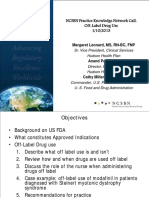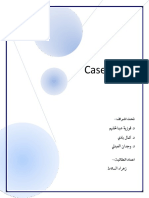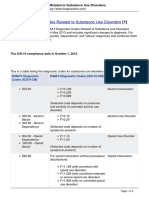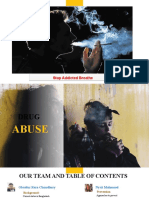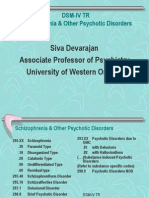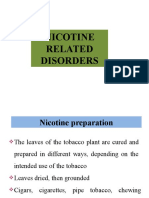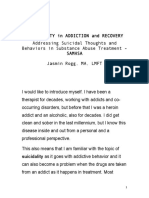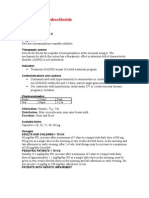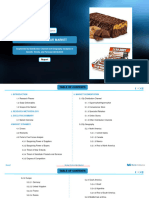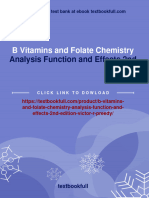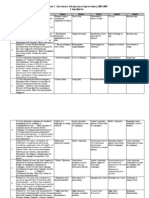Classification of Drugs Non Psychoactive Drugs
Classification of Drugs Non Psychoactive Drugs
Uploaded by
Arnie CabralCopyright:
Available Formats
Classification of Drugs Non Psychoactive Drugs
Classification of Drugs Non Psychoactive Drugs
Uploaded by
Arnie CabralOriginal Description:
Original Title
Copyright
Available Formats
Share this document
Did you find this document useful?
Is this content inappropriate?
Copyright:
Available Formats
Classification of Drugs Non Psychoactive Drugs
Classification of Drugs Non Psychoactive Drugs
Uploaded by
Arnie CabralCopyright:
Available Formats
Classification of Drugs
Non Psychoactive Drugs
o Substances that do not directly affect the brain
when taken in normal doses .
Vitamins
Antibiotics
topical skin preparations
Psychoactive Drugs
o Substances that affect brain functions, mood,
and behavior and are subdivided primarily on
the basis of physiological and psychological
effects.
Narcotic analgesics
central nervous system depressants
central nervous system stimulants
hallucinogens
cannabis sativa: marijuana and
hashish
inhalants: volatile solvents
phencyclidine (PCP)
What is a Psychoactive Drug?
Any substance that directly alters the normal functioning
of the CNS
The major classifications of drugs are uppers
(stimulants), downers (depressants), and all-arounders
(psychedelics or hallucinogens).
Schedules of Classification
Schedule I drugs have a high potential for abuse and
have no currently accepted medical use such as heroin,
marijuana, methaqualone, and LSD.
Schedule II drugs have a high potential for abuse and
have medical use with severe restrictions such as
cocaine, PCP, and most amphetamine and barbiturate
prescriptions.
Schedule III drugs have less potential for abuse and a
currently accepted medical use such as all barbiturate
prescriptions not covered under Schedule II, such as
codeine and anabolic steroids.
Schedule IV drugs have a low potential for abuse and
have a current medical use such as darvon,
phenobarbital, and some tranquilizers such as diazepam
(valium) and chlordiazepoxide (librium).
Schedule V drugs must show low abuse potential and
have medical use such as opiate drug mixtures that
contain nonnarcotic medicinal ingredients.
Drug classification
Class A These include heroin, cocaine, ecstasy and
LSD. If found guilty by a court of law of possessing Class
A drugs you could go to prison for up to seven years and
be fined. If you sell Class A drugs you could receive a
life imprisonment.
Class B These include amphetamines such as speed
and barbiturates. People found guilty of possessing a
Class B drug could go to jail for up to five years and be
fined. Those caught and found guilty of trafficking a Class
B drug can be sent to prison for up to 14 years.
Class C Drugs in this category include, cannabis,
tranquillisers, valium and anabolic steroids. It is illegal to
have, give away or deal in Class C drugs, and to grow
cannabis plants. Maximum penalties for possession are
two years in jail plus an unlimited fine. Dealing or
supplying could get you 14 years in jail plus an unlimited
fine.
1. Narcotics/Opiates
Narcotic comes from the Greek term narcosis, which
means to numb.
Narcotic analgesics come from the poppy plant. These
include:
o Morphine, codeine, heroin
Narcotics are the oldest, and the strongest, analgesics
(pain-relieving) drugs known to mankind. In ancient
Sumer and Egypt, medical texts detailing the use of the
opium poppy to treat coughs, insomnia and pain date as
far back as 4000 B.C.E.
Opium was the first opioid to be used and was a common
folk remedy for centuries before its addictive properties
were recognized; as widespread opium addiction
became a problem during the 19th century, laws limiting
and regulating its use were passed.
Narcotics - Uses
o Narcotics are used as analgesics for pain
control, such as after oral surgery, for severe
menstrual cramps, or for temporary pain relief in
other outpatient surgical procedures.
o Intravenous narcotics are also used for palliative
care in relieving pain of patients diagnosed with
terminal cancer.
o As antitussives, narcotics are commonly used
as cough suppressants. Codeine is a common
ingredient in prescription cough medications.
o Narcotics are also used as antidiarrheal
medications; Paregoric, a liquid tincture
containing powdered opium, anise oil and
glycerine is sometimes prescribed for severe
diarrhea.
Narcotics Effects
o Narcotics have a number of physical side
effects, including:
o Constipation, Drowsiness, Euphoria, Analgesia,
Visual impairment, Respiratory depression,
Reduced anxiety, Sedation, Skin irritation,
Nausea.
Similar Drugs
o Narcotics are classified into three groups
according to their origins.
o Natural derivatives of opium include morphine
and codeine.
o Partially synthetic drugs derived from morphine
include heroin, oxycodone, hydromorphone, and
oxymorphone.
o Synthetic compounds that resemble morphine
chemically
include fentanyl,
levorphanol,
meperidine, methadone, and propoxyphene.
a. Methadone
It was developed in Germany in 1937 and introduced into
the United States in 1947 by Eli Lilly and Company.
Methadone Uses
o Methadone is used medically in tablet form or
concentrate form as an analgesic, a reliever of
chronic pain, and as a maintenance antiaddictive medication in the treatment of opioid
dependence. Additionally, Researchers in
Germany have discovered that Methadone has
surprising killing power against leukemia cells,
including treatment-resistant forms of the
cancer.
Methadone - Effects
o eliminates the use of illicit opiates, the
criminality associated with opiate use, and
allows patients to improve their health and
social productivity
o reduce the transmission of infectious diseases
associated with opiate injection, such as
hepatitis and HIV.
o relieve narcotic craving, suppress the
abstinence syndrome, and block the euphoric
effects associated with opiates.
o Adverse effects of Methadone include
thrombus,
hypoventilation,
constipation;
increased sweating, heat tolerance, chronic
fatigue; sleepiness, exhaustion, constricted
pupils; nausea, low blood pressure,
hallucination; headache, vomiting, cardiac
arrhythmia;
anorexia,
weight
gain,
gynecomastia; stomach pains, dry mouth,
perspiration; flushing, itching, difficulty urinating;
swelling of hands, feet, arms and legs; agitation,
mood swings, blurred vision; insomnia,
impotence, skin rash; seizures and, in some
cases, sudden death.
b. Heroin
Heroin is the common name for Diacetylmorphine, a
semi-synthetic form of morphine, which is more fat
soluble and therefore more potent, than the original
morphine.
Heroin is simultaneously the most addictive and most
physically harmful substance of abuse according to the
current body of research on addiction.
Heroin is a product of the Opium Poppy, which has been
used for its narcotic properties for several millennia.
The earliest known cultivation of opium poppies was in
Mesopotamia circa 3400 BCE.
Heroin was first synthesized by C. R. Alder Wright in
1874, but nothing came of his discovery. In 1897 it was
independently rediscovered by Felix Hoffmann at the
Bayer pharmaceutical company (then known as
Aktiengesellshaft Farbenfabriken) while trying to convert
morphine into codeine..
Heroin - Classification
o Heroin is a central nervous depressant from the
opiate family. In the US it is classified as a
Schedule I Narcotic.
Heroin - Uses
o Injection provides the fastest rush and greatest
intensity of the drug, usually within seconds,
followed by smoking, suppository, snorting, and
swallowing.
o Injection, Smoking , Insufflation, Suppository,
Oral use
Effects of Heroin Use
o Immediate Effects Include:
o Numbness and dulling of pain, Euphoria,
Shallow breathing/respiratory depression,
Bradycardia (dangerously low heart rate),
Hypotension
(low
blood
pressure),
Confusion/Delirium/Disorientation/Poor mental
functioning
o Long-Term Effects Include: Abuse and
dependence, Infectious diseases (HIV/AIDS,
TB, Hepatitis), Collapsed veins, Bacterial
infections, Abscesses, Heart damage and
failure, Arthritis , Weight loss, Hyponatremia
(excessively low sodium levels)
c. Vicodin
Oxycodone, the active constituent in vicodin, was first
developed by Freund and Speyer of the University of
Frankfurt in Germany in 1916, a few years after the
German pharmaceutical company Bayer had stopped the
mass production of Heroin due to addiction and
dependence among its users.
Vicodin - Classification
o Vicodin is a narcotic pain reliever and is
classified as a Schedule III controlled substance
in the U.S.
Vicodin - Uses
o Vicodin is a tablet that is used mainly to treat
minor to moderate physical pain in individuals
who have injured themselves or are recovering
from minor to moderate surgery.
Vicodine - Effects
o The physical effects of Vicodin include shallow
breathing, slow heartbeat, feeling light-headed;
fainting, confusion, fear; unusual thoughts or
behavior, seizure (convulsions), problems with
urination; nausea, upper stomach pain, itching;
loss of appetite, dark urine, clay-colored stools
and jaundice (yellowing of the skin or eyes).
2. Depressants
Drugs that are used as sedatives or hypnotics.
Depressants are psychoactive drugs which temporarily
diminish the normal function of the brain and central
nervous system.
These drugs include opiates and opioids, barbiturates,
benzodiazepines, tranquilizers and alcohol
Due to their effects, these drugs can be referred to as
"downers".
Depressants Side Effects
o Anxiolysis,
Analgesia,
Sedation,
Somnolence/sleepiness,
Cognitive/Memory
Impairment, Dissociation, Muscle relaxation,
Lowered blood pressure/heart rate, Respiratory
depression, Anesthesia, Anticonvulsant effects,
Feelings of euphoria
Depressants Health Effects
o Most CNS depressants act on the brain by
affecting
the
neurotransmitter
gammaaminobutyric
acid
(GABA).
Neurotransmitters are brain chemicals that
enable communication between brain cells.
o GABA works by decreasing brain activity. So,
due to depressants ability to increase GABA
activity, a drowsy or calming effect is produced.
o With continued use of depressants, the body will
develop a tolerance for the drugs, requiring
larger doses to achieve the initial effects.
a. Alcohol
Acts as a depressant on the central nervous system. Is
the most widely used psychoactive drug known (other
than tobacco products). Has major effects on the brain,
peripheral nerves, GI tract, heart and blood vessels, and
the lungs. Time is the only method of sobering-up.
Types of alcohol include beer, wine, and liquor. Alcohol is
a psychoactive drug that reduces attention and slows
reaction speed.
Alcohol intoxication affects the brain, causing slurred
speech, clumsiness, and delayed reflexes.
Other physiological effects include altered perception of
space and time, reduced psychomotor skills, disrupting
equilibrium.
Alcohol Classification
Ethanol is not only a psychoactive, but also a rocket fuel,
solvent, disinfectant and an ingredient in many practical
applications other than as a drug and culinary ingredient.
Anxiolytics - Anything that has the potential to decrease
anxiety at the experiential level.
GABAergics - GABA is the main inhibitory
neurotransmitter of the mammalian central nervous
system.
b. Benzodiazepines
Benzodiazepine, commonly referred to as "benzo", are
most commonly used to treat insomnia and anxiety.
The
five
most
common
benzos
are Xanax, Ativan, Klonopin, Valium,
and
Restoril.
Benzodiazepines are used to produce sedation, induce
sleep, relieve anxiety and muscle spasms (contraction of
muscle), and to prevent seizures.
The first benzodiazepine, Chlordiazepoxide (Librium),
was discovered accidentally by Leo Sternbach in 1955,
and made available by 1960 by Hoffmann-La Roche.
Following Chlordiazepoxide, Diazepam was synthesized
in 1959 and marketed by Hoffmann La Roche under the
brand name Valium in 1963.
Oxazepam was synthesized in 1961, Nitrazepam in
1962, and Temazepam and Nimetazepam in 1964.
Benzo - Classification
o Internationally, benzodiazepines are classified
as Schedule IV controlled drugs by the
International Narcotics Control Board
Benzodiazepines - Uses
o sedative, hypnotic, anxiolytic, anticonvulsant,
muscle relaxant, and amnesic actions, and are
used in treating anxiety, insomnia, agitation;
seizures, muscle spasms, alcohol withdrawal,
and as a premedication for medical or dental
procedures.
o administered orally; however, they can also be
given intravenously, intramuscularly, or rectally
Benzodiazepines - Effects
Physical effects of benzodiazepines include drowsiness,
dizziness, and decreased alertness and concentration.
Decreased libido, sexual dysfunction, and depression are
also a common side effect. Hypotension and suppressed
breathing may be encountered with intravenous use
adversely affects cognition, the formation and
consolidation of new memories, and can potentially
induce complete anterograde amnesia.
c. Barbiturates
Prescribed to induce sleep and relax the nervous system.
Affect areas of the brain that are related to sleep more
than other sedative hypnotics.
Usually taken orally and are readily absorbed.
Barbiturates are a group of drugs known as sedativehypnotics, creating sleep-inducing and anxietydecreasing effects.
Barbiturates produce effects from mild sedation to total
anesthesia. Barbiturates can be injected into veins or
muscles, but usually taken in pill form.
Barbiturates - Effects
o Users report that a barbiturate high gives
feelings of relaxed contentment and euphoria.
o The main risk of abuse is respiratory
depression. Other effects of barbiturate
intoxication include drowsiness, lateral and
vertical nystagmus (involuntary eye movement),
slurred speech and ataxia, decreased anxiety
and loss of inhibitions.
d. Tranquilizers
Tranquilizers are used to treat anxiety or problems with
sleep. They have a calming effect by depressing the
nervous system in a way similar to alcohol.
They are the most commonly prescribed psychiatric
medications. They produce a relaxing and anxietyreducing effect. Minor tranquilizers have direct
depressant effects on brain areas that regulate
wakefulness and alertness.
3. Stimulants/Uppers
Stimulants are substances that increase, or stimulate the
normal activity of the central nervous system. In other
words, they increase the normal level of awareness,
alertness and energy in one's mind and body.
They usually have side-effects and if you take them for
an extended period of time, you may become dependent
upon them.
There are both legal and illegal stimulants.
Stimulant Drugs
Legal stimulants include:
o Caffeine, Nicotine (found in tobacco
products), Weight loss pills, Energy drinks,
Prescription Amphetamines used to treat
ADD or ADHD, such as Adderall, Desoxyn,
Dexadrine.
Illegal stimulants include Methamphetamine, Crack,
Cocaine, Ecstasy (which known as a common "trip"
drug), Amphetamines
Prescribed primarily for narcolepsy, hyperkinetic
syndrome in children, certain mental conditions, and
short-term weight control.
Can be taken orally or injected intravenously.
Prolonged use leads to dehydration, weight loss, vitamin
deficiency, reduced immune system, liver and
cardiovascular disease, hypertensive disorders, and
psychiatric problems.
a. Adderall
Shire Pharmaceuticals first introduced Adderall in 1996 in
the form of a multi-dose, instant-release tablet derived
from the weight management drug Obetrol.
In 2006, Shire sold the rights of Adderall to another
pharmaceutical company.
Adderall - classification
o The active ingredients in Adderall include a
combination of dextroamphetamine and
amphetamine salts
o Amphetamine salts have a high potential for
physical addiction and are considered to be
Schedule II drugs by the Drug Enforcement
Administration.
Adderall - uses
Adderall can be prescribed to treat the
symptoms of attention-deficit hyperactivity
disorder and narcolepsy.
Adderall - Effects
o Short term use can decrease appetite, which
leads to weight loss. Amphetamines also
increase blood pressure, which can lead to
serious and fatal consequences.
o Prolonged Adderall use can lead to insomnia,
irritability, psychosis, sexual dysfunction
and depression
o
b. Cocaine
Has gained popularity in a wide variety of drug forms,
including crack cocaine. Can be inhaled, injected or
smoked (including freebase smoking).
Is short-acting; after the euphoria, psychological
depression, nervousness, fatigue, and irritability set in.
Cocaine is the most addicting drug known today.
Cocaine is both a stimulant of the central nervous system
as well as an appetite suppressant.
Common street names for cocaine are blow, snow, flake,
and nose candy.
c. Crystal Meth/Shabu
Crystal methamphetamine or crystal meth is a colorless,
odorless form of d-methamphetamine, a powerful and
highly addictive synthetic (man-made) stimulant.
It is closely related to amphetamine drugs but has a
longer lasting and more toxic effect on the central
nervous system.
Crystal methamphetamine typically resembles small
shards of glass or shiny blue rocks of various sizes,
which is why it is sometimes called rock, glass and ice.
Crystal methamphetamine is abused because of the
long-lasting euphoric effects it produces.
Crystal methamphetamine is an illegal drug. It is
classified as a Schedule II substance under the
Controlled Substances Act.
Schedule II drugs, which include cocaine and PCP, have
a high potential for abuse. Abuse of these drugs
commonly leads to severe psychological and/or physical
dependence.
d. Ecstacy
Ecstasy or MDMA is a synthetic (man-made) drug with
amphetamine-like and hallucinogenic-like qualities. It was
first made in 1912 by a German company to be used as
an appetite suppressant. Today Ecstasy is most often
distributed at late-night parties called "raves", nightclubs,
and rock concerts. It is classified as a Schedule I drug
and a stimulant.
MDMA (short for Methylenedioxymethamphetamine) is a
psychoactive drug chemically similar to the stimulant
methamphetamine and the hallucinogen mescaline.
MDMA is an illegal drug that acts as both a stimulant and
psychedelic, producing an energizing effect, as well as
distortions in time and perception and enhanced
enjoyment from tactile experiences.
Ecstacy - Effects
o Almost 60 percent of people who use MDMA
report withdrawal symptoms, including fatigue,
loss of appetite, depressed feelings, and trouble
concentrating.
Street names for MDMA include Ecstasy, Ecstacy, X,
Adam, XTC, hug, beans, and love drug.
e. Nicotine
Comes from the tobacco plant.
Nicoteine is is extremely powerful and is at least as
strong as addictions to other drugs such as heroin and
cocaine.
Tobacco
o Is the most widely abused drug.
o Single-leading cause of preventable death in
this country.
Diseases related to smoking tobacco.
o heart disease, peripheral vascular disease,
cerebrovascular disease, cancer, chronic
obstructive lung disease
f. Caffeine
Caffeine present in two and a half cups of coffee may
increase endurance, but does not improve performance
during maximal short-term bursts of exercise.
Caffeine increases urine output, causing potential
implications for the hydration status.
Adverse effects are dose-related and may include:
headaches, tremors, nausea, irregular heartbeat,
restlessness, anxiety, insomnia.
Withdrawal symptoms may include: headaches,
drowsiness, lethargy, irritability, depression.
g. Amphetamine
Are stimulants that people take to keep them alert.
Usually taken by mouth in a powder form but is
sometimes prepared for injection making it even more
dangerous.
Most people agree that amphetamines improve
alertness. However . . .
Amphetamines do NOT prevent fatigue, but mask
fatigues which can lead to disaster!
By diminishing pain thresholds, athletes are allowed to
continue to compete despite injury, potentially causing
more damage.
There is an added potential for injury to others in contact
sports because of the increase in aggressiveness caused
by amphetamine use.
4. Hallucinogens
Hallucinogen is derived from the Latin term hallucinari,
which means to wander in the mind.
Defined as:
o Psychedelic - alters consciousness
o Psychotomimetic - mimics psychosis
o Psychotogenic - produces psychosis
Hallucinogens are a type of drug that cause subjective
changes in thought, emotion, perception and
consciousness.
Ex: Marijuana, LSD, PCP, psilocybin mushrooms, and
peyote.
Major effects: These drugs enhance sensory perceptions
- sight, sound, smell and touch.
Illusions, hallucinations, & confused sensations.
Bad Trip vs. Good Trip
a. LSD
Is the most potent drug by weight, and is the most
thoroughly researched.
Is often impregnated in sugar pills, blotter paper, or small
gelatin squares for ingestion.
Can produce profound effects on thinking, selfawareness, and emotions.
Physical dependence is unlikely, however psychological
dependence is common in long-term users.
b. Cannabis Sativa (Marijuana)
Cannabis refers to any product of the plant Canabis
sativa.
Can be smoked in hand-rolled cigarettes or joints.
Higher-potency marijuana is usually smoked in a water
pipe.
Effects include exhilaration, relaxation, heart rate
increase, drowsiness, dry mouth and throat, bloodshot
eyes, impaired short-term memory, altered states of time
and space, and dilated pupils.
Cannabis has an ancient history of ritual use and is found
in pharmacological cults around the world. It is known to
have been used as long ago as the 3rd millenium BC, by
indigenous people of Central and South Asia, ancient
Hindus, Indians and Assyrians. Settlements dating back
from c. 2200 to 1700 BCE in the Bactria and Margiana
regions show evidence of cannabis consumption for
religious and spiritual rituals.
Cannabis - Classification
o Cannabis is classified by the DEA as a
Schedule I drug, making the manufacture,
possession, sale, and use of cannabis by
anyone punishable by federal law.
Cannabis - Uses
o Cannabis is consumed in many different ways,
most of which involve inhaling vaporized
cannabinoids ("smoke") from small pipes,
bongs, joints, or tobacco-leaf-wrapped blunts.
Fresh, non-dried cannabis may also be
consumed orally.
o In the later part of the 20th century, the medical
field began to experiment with cannabis as an
alternative medication in treating a variety of
conditions, including nausea and vomiting; its
use has also been applied to the stimulation of
appetite, the discomfort of chemotherapy for
AIDS patients, glaucoma, multiple sclerosis,
depression and anxiety.
Cannabis - Effects
o Cannabis has psychoactive and physiological
effects when consumed. Cannabis causes a
subjective change in perception and mood, and
the most common short-term physical and
neurological effects include increased heart
rate, lowered blood pressure; impairment of
short-term and working memory, psychomotor
coordination, and concentration.
5. Inhalants
Most inhalants are common household products that give
off mind-altering chemical fumes when sniffed.
When inhaled solvents have a similar effect to alcohol
Adverse effects include: confusion, drunkenness, slurred
speech, numbness, runny nose, tears, headache,
incoordination, nausea, vomiting, confusion, panic,
irritation, tension, hyperactivity, aggressiveness,
drowsiness,
stupor,
respiratory
depression,
unconsciousness, difficulty breathing, ulcers around
mouth and nose, weight loss, nutritional disorders, death.
6. Phencyclidine (PCP)
Cannot be properly classified as a hallucinogen,
stimulant, or a depressant, causing it to be listed in a
separate drug category.
Can be smoked or ingested, and occasionally is
injectable.
Effects
include:
euphoria,
auditory/visual/time
disturbances, loss of muscle control, delusions,
tranquilization, inebriation, dissociation, changes in body
imagery, perceptual distortions, feelings of apathy and
estrangement, drowsiness, inability to verbalize, difficulty
thinking, poor concentration, preoccupation with death.
Phencyclidine or PCP is a dissociative type of anesthetic
with hallucinogenic properties. It was developed in the
1950's as an anesthetic and administered intravenously.
After reports of delusions, psychosis, and other side
effects PCP was restricted to veterinary purposes, and
then was eventually discontinued. The drug is commonly
referred to as "wet" or "amp", when PCP is snorted,
ingested or when it is smoked on top of marijuana or
other leaves it may be called a "sherm" or "dipper".
PCP - Uses
o PCP was created in 1926 and later tested post
World War II as a surgical anesthetic. Due to the
number of adverse effects, it was taken off the
market until the 1950s. In 1967, it was marketed
under the name Sernylan and used as a
veterinary anesthetic, but was again
discontinued.
PCP - Effects
o Because PCP produces a loss of feeling,
accidents causing injury are common.
o High or consistent doses have led to incidents
of violence.
o Adverse reactions may include: paranoia,
agitation, withdrawn or isolated feeling, bizarre
delusions, increased heart rate/blood pressure,
sweating, salivation, flushing, nystagmus (jerky
eye movements).
7. Steroids
Androgenic steroids
o Include testosterone. Primarily develop and
maintain male sex characteristics.
Anabolic steroids
o Are synthetic derivatives of testosterone
developed in an attempt to minimize
testosterones androgenic or masculinizing
effects on the individual while promoting protein
synthesis and muscular growth.
Major effects of steroid use: significant increases in
strength, increases in lean body mass, increased ability
to perform high-intensity training sessions
Adverse effects of steroid use: heart disease, elevated
blood pressure, reduction of high density lipoproteins that
aid in removing cholesterol, stunted growth.
Adverse effects on men:
liver and kidney damage, breast development, acne,
baldness, cysts, shrinking of the testicles, sterility,
reduced sex drive, headaches, nausea, dizziness.
Adverse effects on women: infertility, clitoral
enlargement, breast atrophy, menstrual irregularities,
male pattern baldness, voice change.
Evidence is emerging that the most significant effect of
steroid use is psychological.
Aggressiveness, mood swings, depression, delusions,
loss of control, continued use despite known adverse
consequences, tolerance, withdrawal.
These effects suggest that both
psychological dependence may occur.
physical and
You might also like
- PSYCH 505 Case Study Core FunctionsDocument8 pagesPSYCH 505 Case Study Core FunctionsHugsNo ratings yet
- The Spectrum of Addiction: Evidence-Based Assessment, Prevention, and Treatment Across The LifespanDocument20 pagesThe Spectrum of Addiction: Evidence-Based Assessment, Prevention, and Treatment Across The Lifespanalexandra marulandaNo ratings yet
- The Prevalence of Substance Use and Other Mental Health Concerns Among American AttorneysDocument7 pagesThe Prevalence of Substance Use and Other Mental Health Concerns Among American AttorneysDavid AndreattaNo ratings yet
- Drug Abuse and AddictionDocument17 pagesDrug Abuse and AddictionSyafiqah ZainordinNo ratings yet
- Chapter 2Document2 pagesChapter 2Melissa Jean HintonNo ratings yet
- MethamphetamineDocument29 pagesMethamphetamineHafsa BilalNo ratings yet
- TASK 2 - PMG517 Risk Management TemplateDocument9 pagesTASK 2 - PMG517 Risk Management TemplateShravani PulgamNo ratings yet
- Peg TubeDocument14 pagesPeg Tubejonisyang100% (1)
- Lawrence J. Albers, MD: 2005 EditionDocument68 pagesLawrence J. Albers, MD: 2005 EditionAlex VimanNo ratings yet
- A Reading On Substance Abuse and Nursing - Patient InteractionDocument10 pagesA Reading On Substance Abuse and Nursing - Patient InteractionyuviebNo ratings yet
- Substance Abuse Power PointDocument65 pagesSubstance Abuse Power PointFletcher1980No ratings yet
- Prozac (Fluoxetine) 40mgDocument1 pageProzac (Fluoxetine) 40mgENo ratings yet
- NCSBN Practice Knowledge Network Call: Off-Label Drug Use 1/10/2013Document23 pagesNCSBN Practice Knowledge Network Call: Off-Label Drug Use 1/10/2013Ari NurfikriNo ratings yet
- Midterm Exam Study GuideDocument6 pagesMidterm Exam Study GuideDel KenzieNo ratings yet
- Midyear Training CADCA MYTI14 - Program - FinalDocument48 pagesMidyear Training CADCA MYTI14 - Program - FinalRuss BelvilleNo ratings yet
- Inaba Current TrendsUppers, Downers, All Arounders Naadac AtlantaDocument236 pagesInaba Current TrendsUppers, Downers, All Arounders Naadac Atlantaalimusa1100% (3)
- Reading On Substance Abuse-MataDocument13 pagesReading On Substance Abuse-MataNicole Keesha MataNo ratings yet
- Wrap (Wellness Recovery Action Plan) Western AustraliaDocument4 pagesWrap (Wellness Recovery Action Plan) Western AustraliagavinbuzzNo ratings yet
- 421 - NeurobiologyDocument38 pages421 - NeurobiologymelodyfathiNo ratings yet
- Use Drugs - Pay To Die Drugs AddictionDocument11 pagesUse Drugs - Pay To Die Drugs AddictionelvineNo ratings yet
- Mental Health & Substance Abuse Drug Abuse Monitoring SystemDocument29 pagesMental Health & Substance Abuse Drug Abuse Monitoring SystemRavi Gaura Das100% (1)
- Marijuana THC PresentationDocument21 pagesMarijuana THC PresentationJomariexOrtizNo ratings yet
- Drug Addiction CausesDocument2 pagesDrug Addiction Causesstudent07No ratings yet
- Psychopharmacology 1Document7 pagesPsychopharmacology 1RajP01No ratings yet
- Drug AddictionDocument51 pagesDrug AddictionKristine SaulerNo ratings yet
- Chapter 7 Individual TreatmentDocument4 pagesChapter 7 Individual TreatmentCory HarnessNo ratings yet
- The Cycle of ViolenceDocument2 pagesThe Cycle of ViolenceEngr Fahimuddin QureshiNo ratings yet
- Substance Abuse PsychologyDocument8 pagesSubstance Abuse PsychologyJohn Glenn BalacanoNo ratings yet
- Substance Abuse in Children and AdolescentsDocument65 pagesSubstance Abuse in Children and AdolescentsDr. cebastaNo ratings yet
- PAws Samsha PDFDocument8 pagesPAws Samsha PDFAnonymous JS9PXY2100% (1)
- Serotonin, Psilocybin and Body Dysmorphic Disorder - A Case ReportDocument2 pagesSerotonin, Psilocybin and Body Dysmorphic Disorder - A Case ReportDayon BochniaNo ratings yet
- Case StudyDocument14 pagesCase StudyCooky DNo ratings yet
- CADCDocument3 pagesCADCCarlos P CantuNo ratings yet
- PDF Drugs, Society, and Human Behavior 18th Edition Carl L. Hart. downloadDocument49 pagesPDF Drugs, Society, and Human Behavior 18th Edition Carl L. Hart. downloadsaoryarhp100% (2)
- Mental Illness: Antianxiety Agents. Drugs Used To Treat Anxiety Disorders and Symptoms. These IncludeDocument14 pagesMental Illness: Antianxiety Agents. Drugs Used To Treat Anxiety Disorders and Symptoms. These IncludeLeeNo ratings yet
- Schizoaffective Disorder FactsheetDocument6 pagesSchizoaffective Disorder FactsheetYusnida RahmawatiNo ratings yet
- Narcotics Anonymous Meeting 3Document6 pagesNarcotics Anonymous Meeting 3api-401390929No ratings yet
- Co-Occurring Addiction and Mental DisordersDocument98 pagesCo-Occurring Addiction and Mental DisordersAnonymous nz9rhHNo ratings yet
- Stimulants: Jeremy LuoDocument30 pagesStimulants: Jeremy LuoJeremy LuoNo ratings yet
- Psychiatric Emergencies: Miriti M.D Masters of Clinical Medicine Accidents and Emergency Facilitator: DR AyungaDocument25 pagesPsychiatric Emergencies: Miriti M.D Masters of Clinical Medicine Accidents and Emergency Facilitator: DR AyungaDennis MiritiNo ratings yet
- Twelve Core Functions of The CounselorDocument6 pagesTwelve Core Functions of The Counselorpaul machariaNo ratings yet
- Addiction ScriptDocument19 pagesAddiction ScriptLaica A. LunetaNo ratings yet
- Drug Addiction by .Final - EPI.V5Document52 pagesDrug Addiction by .Final - EPI.V5Mohaiminur RahmanNo ratings yet
- 12 Core FunctionsDocument14 pages12 Core Functionszaelany jrNo ratings yet
- Drug Abuse and DependenceDocument18 pagesDrug Abuse and DependenceAkash AroraNo ratings yet
- Antidepressant DrugsDocument55 pagesAntidepressant Drugsmaheen aurangzaib100% (2)
- Substance AbuseDocument32 pagesSubstance AbuseGanga SinghNo ratings yet
- Co-Occurring Disorders Summary Notes (April Furlong, CAMH)Document6 pagesCo-Occurring Disorders Summary Notes (April Furlong, CAMH)dbbluesNo ratings yet
- Psychotic DisordersDocument28 pagesPsychotic DisordersGlessica YouNo ratings yet
- 7teste Gramatica RomanaDocument37 pages7teste Gramatica RomanaStacia CunninghamNo ratings yet
- Nicotine Related DisordersDocument74 pagesNicotine Related DisordersKuldeep singhNo ratings yet
- Mdd-Case StudyDocument30 pagesMdd-Case Studyapi-315145911No ratings yet
- SSRIs and Sexual DisfunctionDocument6 pagesSSRIs and Sexual Disfunctionzatanna10No ratings yet
- Clinical Pharmacokinetics of FluoxetineDocument14 pagesClinical Pharmacokinetics of FluoxetinePalwasha MalikNo ratings yet
- SUICIDALITY in ADDICTION and RECOVERYDocument24 pagesSUICIDALITY in ADDICTION and RECOVERYAlguémNo ratings yet
- Atomoxetine Hydro ChlorideDocument3 pagesAtomoxetine Hydro Chlorideapi-3797941No ratings yet
- Durg Addition PrsentaionDocument28 pagesDurg Addition PrsentaionDr. Kaushal Kishor SharmaNo ratings yet
- NewJersey06 12 Core FunctionsDocument11 pagesNewJersey06 12 Core FunctionsChinchusha T JanardhananNo ratings yet
- Cameroon: National ReportDocument25 pagesCameroon: National ReportguyNo ratings yet
- Global Protein Bar Market - Growth, Trends, and Forecasts (2019 - 2024)Document119 pagesGlobal Protein Bar Market - Growth, Trends, and Forecasts (2019 - 2024)MEHUL CHOUDHARYNo ratings yet
- Endoscopic Sleeve Gastroplasty in 109 Consecutive Children and Adolescents With Obesity: Two-Year Outcomes of A New ModalityDocument6 pagesEndoscopic Sleeve Gastroplasty in 109 Consecutive Children and Adolescents With Obesity: Two-Year Outcomes of A New ModalityMohamedOmerElahmediNo ratings yet
- Full Download B Vitamins and Folate Chemistry Analysis Function and Effects 2nd Edition Victor R Preedy PDFDocument53 pagesFull Download B Vitamins and Folate Chemistry Analysis Function and Effects 2nd Edition Victor R Preedy PDFbetkercomboNo ratings yet
- Neonatal Hypocalcemia: Presented By: Ms. Manisha Thakur Nursing Tutor Child Health NursingDocument11 pagesNeonatal Hypocalcemia: Presented By: Ms. Manisha Thakur Nursing Tutor Child Health Nursingmanisha thakurNo ratings yet
- LAW Sis QuestionPaper - JSP qSetID XhpfPMUvvdEDocument6 pagesLAW Sis QuestionPaper - JSP qSetID XhpfPMUvvdEsonaliNo ratings yet
- Letter To Gov. Sisolak From 200+ Nevada PastorsDocument15 pagesLetter To Gov. Sisolak From 200+ Nevada PastorsShah AhmadNo ratings yet
- Endodontic Microbiology: Review of Literature: January 2011Document14 pagesEndodontic Microbiology: Review of Literature: January 2011Muhammad RaihanNo ratings yet
- PneumothoraxDocument24 pagesPneumothoraxItharshan IndreswaranNo ratings yet
- Pneumoconiosis. Silicosis. Silicatosis. Vibration DiseaseDocument130 pagesPneumoconiosis. Silicosis. Silicatosis. Vibration DiseaseAlina Boghiu-CisleanuNo ratings yet
- Emetics and Antiemetics 2012 PDFDocument36 pagesEmetics and Antiemetics 2012 PDFJamaluddin Ahmad A.M100% (2)
- Benefits of YogaDocument3 pagesBenefits of YogaMana HyderabadNo ratings yet
- KROK-2 2 профиль (79Qs) 2004-2005Document16 pagesKROK-2 2 профиль (79Qs) 2004-2005Ali ZeeshanNo ratings yet
- Sara Mohmmed - GTP1 - Stage03Document16 pagesSara Mohmmed - GTP1 - Stage03saramohmmed130No ratings yet
- Study On Mental Health and Psychosocial Wellbeing of Children and Young People in Viet NamDocument152 pagesStudy On Mental Health and Psychosocial Wellbeing of Children and Young People in Viet NamKim Ngân NguyenNo ratings yet
- Chapter 2 VulnerabilityDocument18 pagesChapter 2 Vulnerabilityallanrnmanaloto62% (13)
- Training - Age Specific CompetencyDocument14 pagesTraining - Age Specific CompetencyKrishna Hospital & Research Centre HaldwaniNo ratings yet
- Rape SpeechDocument3 pagesRape SpeechJayniacJaynerdNo ratings yet
- OFF510+-+Operations+and+maintenance Presentation+1+slide+per+page PDFDocument435 pagesOFF510+-+Operations+and+maintenance Presentation+1+slide+per+page PDFM Ahmad Tauqeer0% (1)
- IMCI Revised For CHN 1 NEW 1st Sem 2022Document82 pagesIMCI Revised For CHN 1 NEW 1st Sem 2022Aech Euie100% (1)
- 8 Sterility Testing of PharmaceuticalsDocument14 pages8 Sterility Testing of PharmaceuticalsGaurav MudaduNo ratings yet
- When Your Body Betrays You: by James HallaDocument4 pagesWhen Your Body Betrays You: by James HallaCris VNo ratings yet
- Dole BWC Ohsd Ip 5 Page 1Document2 pagesDole BWC Ohsd Ip 5 Page 1Yurs100% (1)
- BS Iso 05667-21-2010Document26 pagesBS Iso 05667-21-2010mohamed senoussiNo ratings yet
- Bbacteriology P2Document59 pagesBbacteriology P2Charlene RodrigoNo ratings yet
- Emergency Nurse ResumeDocument5 pagesEmergency Nurse Resumeqwaskmrmd100% (1)
- Best Way To Increase StaminaDocument30 pagesBest Way To Increase StaminaSatish Kumar DashNo ratings yet
- 11 7 12 0204 62337 Bates 2701 To 3,094 Formal Hearing File SBN v. Zachary B. Coughlin SBN Violates SCR 105 (2) (C) With Index LinkDocument394 pages11 7 12 0204 62337 Bates 2701 To 3,094 Formal Hearing File SBN v. Zachary B. Coughlin SBN Violates SCR 105 (2) (C) With Index LinkNevadaGadflyNo ratings yet
















